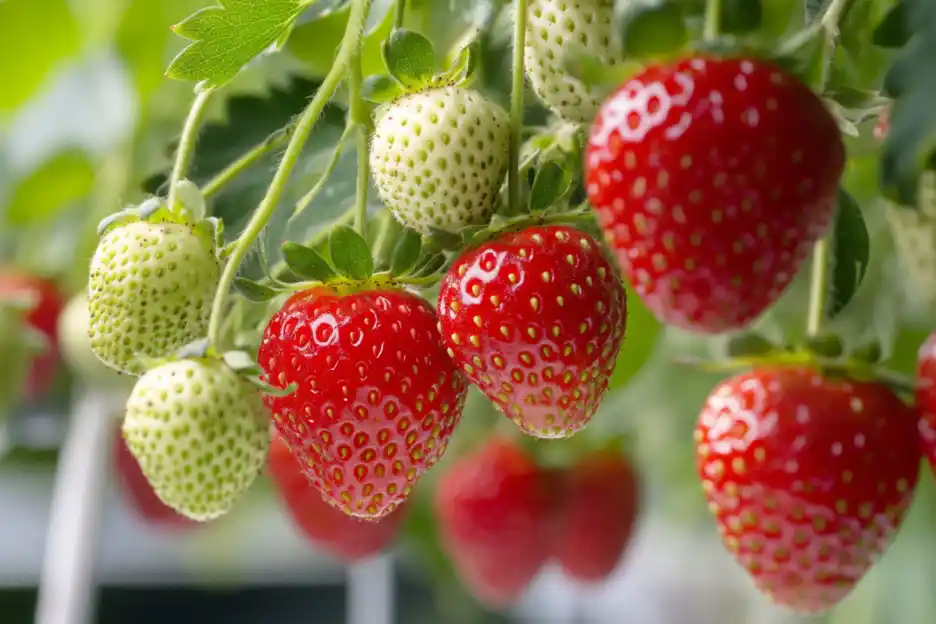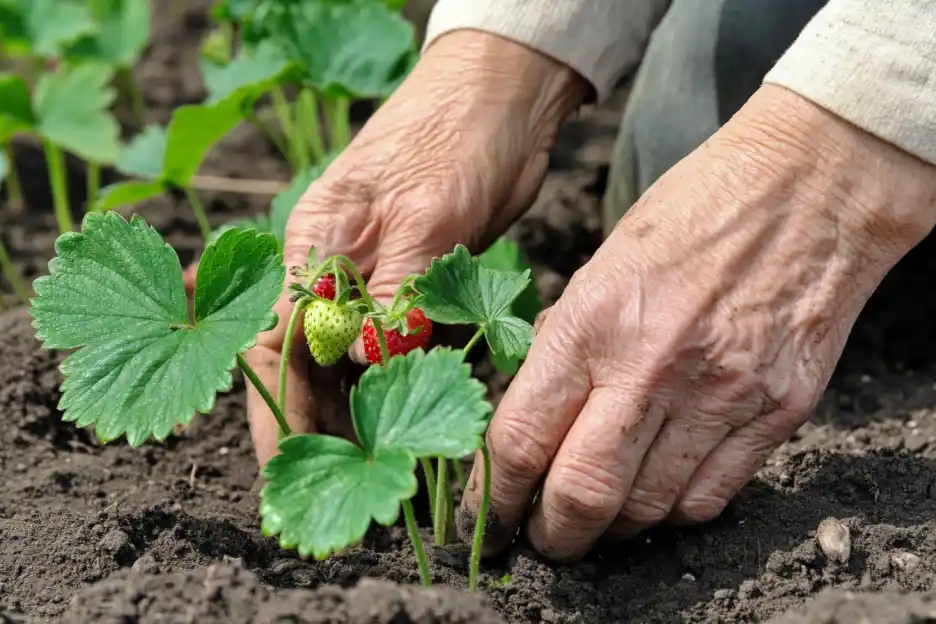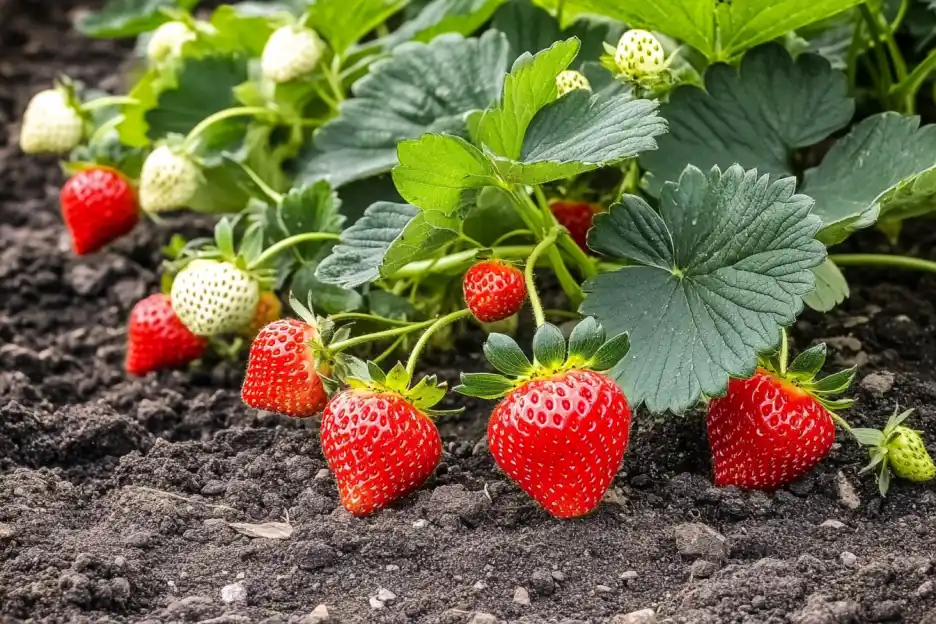Growing strawberries at home is a rewarding endeavor, providing fresh, juicy berries that are perfect for snacks, desserts, and more. Whether you’re growing them in the ground or in containers, strawberries can thrive with the right care. This guide will walk you through everything you need to know to grow strawberries at home, from choosing the best varieties to harvesting your delicious crop.
1. Types of Strawberries to Grow
Strawberries come in three main types, each with its own growing and fruiting habits. Understanding these types can help you choose the best variety for your home garden.
1.1 June-bearing Strawberries
June-bearing strawberries produce one large crop per year, typically in late spring or early summer. These varieties tend to yield the largest berries and are ideal if you want a bountiful harvest for making jams or freezing. Popular varieties include ‘Chandler’ and ‘Allstar’.
1.2 Everbearing Strawberries
Everbearing strawberries produce two to three crops per year: one in spring, another in summer, and sometimes a smaller crop in the fall. While the total yield per harvest is smaller than June-bearers, you’ll have fresh strawberries more frequently throughout the growing season. Varieties like ‘Quinault’ and ‘Ozark Beauty’ are favorites for home gardeners.
1.3 Day-neutral Strawberries
Day-neutral strawberries produce fruit continuously from late spring to fall, as long as temperatures remain between 35°F and 85°F (1.5°C to 29°C). These plants are perfect for gardeners who want a steady supply of berries throughout the season. Some popular day-neutral varieties include ‘Tribute’ and ‘Tristar’.

2. When and Where to Plant Strawberries
To grow strawberries successfully, timing and location are crucial. Here’s how to set the stage for a productive strawberry patch.
2.1 Ideal Planting Times
The best time to plant strawberries is in early spring, just after the last frost. In warmer climates, you can also plant them in the fall for a spring harvest. June-bearing varieties should be planted in early spring, while everbearing and day-neutral types can be planted throughout the season.
Choosing the Right Location for Strawberries
Strawberries thrive in areas with full sun—at least 6-8 hours per day. Choose a location with well-draining soil and good air circulation to prevent disease. Avoid planting strawberries in areas where tomatoes, peppers, or potatoes were grown recently, as they can carry soil-borne diseases that affect strawberries.
For those growing in limited spaces, strawberries also do well in pots and containers, making them an excellent choice for patio or balcony gardening. For more tips on growing fruits in small spaces, check out this beginner’s guide to growing grapes in your garden.’

3. How to Plant Strawberries
Whether you’re planting strawberries in the ground or containers, following these steps will give your plants the best start.
3.1 Planting Strawberries in the Ground
- Spacing: Plant strawberries 18 inches apart in rows that are 2-3 feet apart. This ensures enough room for growth and air circulation.
- Planting Depth: Make sure the crown of the plant (the part where the roots meet the stems) is at soil level. Burying the crown too deep can cause the plant to rot, while planting it too high may dry out the roots.
3.2 Growing Strawberries in Pots or Containers
If space is limited, strawberries can be grown in pots, hanging baskets, or even vertical planters. Use a container with good drainage and at least 12 inches in diameter. Fill the pot with a high-quality potting mix and place it in a sunny location. Container-grown strawberries often need more frequent watering but can yield just as well as those planted in the ground.

3.3 Growing Strawberries from Bare-Root Runners
Bare-root runners are a cost-effective way to plant strawberries. Soak the roots in water for a few hours before planting. Follow the same depth and spacing guidelines as with potted plants, making sure the crowns are just above the soil level.
4. Care Tips for Strawberries
Strawberries are relatively easy to care for, but a few essential tasks will ensure a healthy and productive plant.
4.1 Watering and Soil Needs
Strawberries need about 1-1.5 inches of water per week, especially during the growing and fruiting seasons. Water the plants at the base to avoid wetting the leaves, which can lead to disease. Strawberries prefer slightly acidic soil with a pH between 5.5 and 6.8. Adding compost or organic matter to the soil will improve drainage and nutrient content.
4.2 Fertilizing for Better Growth
Strawberries are heavy feeders and benefit from a balanced fertilizer applied at planting and throughout the growing season. Apply a slow-release fertilizer every 6-8 weeks or use liquid fertilizer every 2-3 weeks to encourage lush growth and abundant fruiting.
4.3 Pruning and Managing Runners
Strawberry plants produce runners (long stems that grow out from the main plant), which can root and produce new plants. To focus the plant’s energy on fruit production, prune runners unless you’re looking to propagate more plants. If you’re growing in a small space or container, keeping runners in check is especially important.

5. How to Harvest Strawberries
Knowing when and how to harvest strawberries is key to enjoying the best flavor and maximizing your yield.
5.2 Signs Your Strawberries Are Ready
Strawberries are ready to harvest when they are fully red and slightly soft to the touch. Check your plants daily during peak season, as strawberries ripen quickly. Avoid picking berries that still have white or green tips, as they won’t ripen after picking.
5.2 Harvesting Tips for Maximum Yield
- Pick in the morning: Harvest strawberries early in the day, before the sun heats them up. This helps preserve their sweetness.
- Handle gently: Strawberries bruise easily, so handle them with care. Pinch or cut the stem just above the fruit rather than pulling it off the plant.

6. Common Strawberry Pests and Diseases
Strawberries can fall prey to pests and diseases, but with some preventive care, you can keep your plants healthy.
6.1 Grey Mould (Botrytis)
This fungal disease thrives in humid, damp conditions and causes fruit to rot. To prevent grey mould, ensure proper spacing between plants for good air circulation, water at the base, and remove any diseased fruit immediately.
6.2 Slugs and Snails
Slugs and snails love strawberries as much as we do. To keep them at bay, use slug traps or spread crushed eggshells around your plants. These pests dislike sharp surfaces and will avoid crossing over them.
6.3 Powdery Mildew
Powdery mildew can cause white, powdery spots on strawberry leaves. To prevent this, plant strawberries in full sun, ensure good airflow, and water at the base of the plant.
For more tips on protecting strawberries and other crops, this external guide to growing strawberries offers helpful insights.

7. Propagating Strawberry Plants
Strawberries are easy to propagate, allowing you to expand your patch without buying new plants.
7.1 How to Propagate Using Runners
One of the easiest ways to propagate strawberries is by using runners. Allow a few runners to root in the soil, and once they establish roots, you can cut them from the parent plant and replant them in another part of your garden.
7.2 Renewing Your Strawberry Patch
Strawberry plants start to decline in productivity after a few years. To keep your patch productive, consider renewing it every 3-4 years. You can do this by allowing runners to replace older plants or planting new bare-root runners in a different location.

Frequently Asked Questions
How much sun do strawberries need?
Strawberries need at least 6-8 hours of full sunlight daily for optimal growth.
Can strawberries grow in containers?
Yes, strawberries do very well in containers, provided they get enough sunlight and water.
How do I prevent pests from eating my strawberries?
To prevent pests like slugs and snails, use traps or barriers, such as crushed eggshells. Keeping your garden clean and removing fallen fruits can also help.
How often should I water my strawberry plants?
Water strawberries deeply once or twice a week, ensuring the soil stays moist but not waterlogged.
What is the best variety of strawberry for home gardens?
For most home gardens, everbearing strawberries are an excellent choice, as they produce multiple crops throughout the season.
Growing strawberries at home is a delightful and rewarding process, whether you plant them in the ground or containers. With the right care, you can enjoy sweet, juicy berries throughout the season. By following the tips in this guide, you’ll be well on your way to a productive strawberry patch.
For more tips on growing fruits at home, don’t forget to check out this helpful guide on growing grapes.


1 thought on “How to Grow Strawberries at Home”